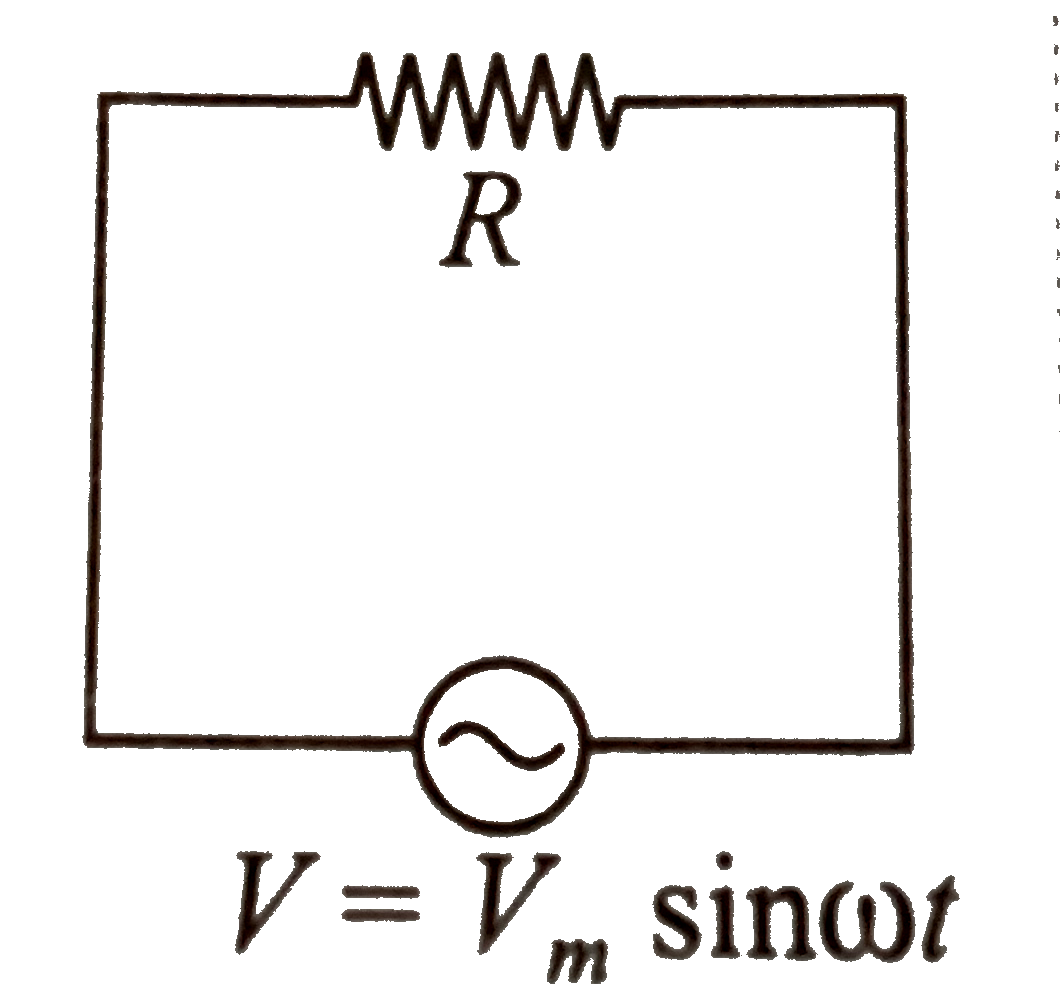A source of a.c. voltage is connected to a series combination of a capacitor C and a resistor R. Draw the phasor diagram and use it to obtain the expression for (i) impedance of the circuit, and (ii) phase angle.
Consider an alternating voltage given by applied to a capacitor C and resistor R joined in series as shown in Fig. 7.28. As C and R are in series, same current I flows in the entire circuit. Let and be the magnitudes of instantaneous values of voltage across the capacitance, resistance and the source. Then, as shown in phasor diagram:

lagging behind in phase by as compared to , and in same phase as that of
These are being represented by phasors OB and OA, respectively. Then, total instantaneous voltage V is given by phasor OC such that:
Impedance offered by the circuit,
Moreover, the phasor diagram indicates that source voltage lags behind the current I (or the circuit current leads the a.c. supply voltage) by a phase angle where,

Topper's Solved these Questions
- ALTERNATING CURRENT Book:U-LIKE SERIESChapter:ALTERNATING CURRENT Exercise:LONG ANSWER QUESTIONS -II
Explore 12 Videos
- ALTERNATING CURRENT Book:U-LIKE SERIESChapter:ALTERNATING CURRENT Exercise:SELF ASSESSMENT TEST (SECTION -A) (MULTIPLE CHOICE QUESTIONS)
Explore 4 Videos
- ALTERNATING CURRENT Book:U-LIKE SERIESChapter:ALTERNATING CURRENT Exercise:SHORT ANSWER QUESTIONS
Explore 32 Videos
- ATOMSBook:U-LIKE SERIESChapter:ATOMSExercise:SELF ASSESSMENT TEST (SECTION C)
Explore 2 Videos
Similar Questions
(a) An a.c. source of voltage V=Vmsinωt is connected across a series combination of an inductor, a capacitor and a resistor. Use the phasor diagram to obtain the expression for
(i) impedance of the circuit, and
(ii) phase angle between the voltage and the current
(b) A capacitor of unknown capacitor, a resistor of 100Ω and an inductor of self-inductance L=4π2H are connected in series to an a.c. source of 200 V and 50 Hz. Calculate the value of the capacitance and the current that flows in the circuit when the current is in phase with the voltage.
View Solution(a) An AC source of voltage V=V0sinωt is connected across a series combination of an inductor a capacitor and a resistor . Use the phasor diagram to obtain the expression for the impedance of the circuit and phase angle between the voltage and the current.
(b) A capacitor of unknown capacitance a resistor of 100 Ω and an inductor of self - inductance L =(4/π2) henry are in series connected to an AC source of 200 V and 50 Hz . Calculate the value of the capacitance and the current that flows in the circuit when the current is in phase with the voltage .
View Solution
Knowledge Check
An AC source producing emf V=V0 "["sin omega t+sin 2omegat"]" is connected in series with a capacitor and a resistor. The current found in the circuit is
Ai1−i2Bi1<i2Ci1>i2Di1 may be less than, equal to or greater than i2An ac source of voltage V=Vmsinωt is connected across the resistance R as shown in figure. The phase relation between current and voltage for this circuit is
 Aboth are in phaseBboth are out of phase by 90∘Cboth are out of phase by 120∘Dboth are out of phase by 180∘
Aboth are in phaseBboth are out of phase by 90∘Cboth are out of phase by 120∘Dboth are out of phase by 180∘
(i) An a.c. source of voltage V=Vmsinωt is connected to a series combination of L, C and R. Use the phasor diagram to obtain expressions for impedance of the circuit and phase angle between voltage and current. Find the condition when current will be in phase with the voltage. What is the circuit in this condition called ?
(ii) In a series LR circuit XL=R and power factor of the circuit is P1 . When capacitor with capacitance C such that XL=XC is put in series, the power factor becomes P2 . Calculate P1/P2
View SolutionAn ac source of voltage V=V0sinωt is connected to a series combination of L, C and R. Use the phasor diagram to obtain expressions for impedance of the circuit and phase with the voltage. What is circuit in this condition called?
View Solution(i) An a.c. Source of voltage V=V0 sin ωt is connected to a series combination of L,C and R . Use the phasor diagram to obtain expression for impedance of the circuit and phase angle between voltage and current . Find the condition when current will be phase with the voltage . What is the circuit in this condition called ?
(ii) In a series LR circuit XL=R and power factor of the circuit is P1. When capacitor which capacitance C such that XL=XC is put in series , the power factor becomes P2 .Calculate P1/P2

View SolutionAn AC source producing emf V=V0 [sin ωt+sin 2ωt] is connected in series with a capacitor and a resistor. The current found in the circuit is i=i1sin 'omega' t +fi 1
View SolutionAn a.c. source, of voltage V=Vmsinωt , is applied across a series LCR circuit. Draw the phasor diagram for the circuit when the
(i) capacitive reactance exceeds the inductive reactance,
(ii) inductive reactance exceeds the capacitive reactance.
View SolutionDraw the phasor diagram for a series RC circuit connected to an a.c. source.
View Solution

